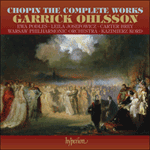Surviving sketches for the
Bolero in A minor in the Paris Conservatoire indicate a composition date of around 1833 – which makes it contemporary with drafts for the G minor ballade and the Op 25 studies. C F Peters of Leipzig published it first in October 1834, with Wessel of London issuing an edition the following August under the title
Souvenir d’Andalousie. More Spanish than a polonaise, more Polish than a bolero (hence Nieck’s tag, ‘Bolero à la Polonaise’), its structure is that of a rondo in A minor/major prefaced by a brillante introduction in C major. Polish is the rhythm of its accompaniment. Iberian is the Aeolian flattened 7th modality of its refrain and the nature of its metric stress (in a true bolero all periods conclude on an assertive downbeat, in a polonaise they don’t, they favour the weaker accent – a nicety of cadencing Chopin observes with alacrity).
from notes by Ateş Orga © 1992
D’après des esquisses du
Boléro en la mineur qui sont au Conservatoire de Paris, ce morceau fut composé vers 1833 – ce qui en fait le contemporain des premiers jets de la ballade en sol mineur et des études opus 25. Le
Boléro fut publié d’abord par C F Peters de Leipzig en octobre 1834 et Wessel de Londres produisit une édition au mois d’août suivant sous le titre de
Souvenir d’Andalousie. Plus espagnol qu’une polonaise, plus polonais qu’un boléro (d’où la description de Niecks, «Boléro à la Polonaise») sa structure est celle d’un rondo en la mineur/majeur préfacé par une brillante introduction en do majeur. Le rythme de son accompagnement est polonais. La 7ème modalité éolienne bémolisée de son refrain est ibérienne … la nature de son accent métrique (dans un boléro authentique toutes les périodes se terminent sur un temps fort affirmatif, dans une polonaise ce n’est pas le cas, elles préfèrent l’accent plus faible – une subtilité dans la cadence que Chopin s’empresse d’observer).
extrait des notes rédigées par Ateş Orga © 1992
Français: Alain Midoux
Im Pariser Conservatoire erhaltene Skizzen zum
Bolero in a-Moll deuten ein Kompositionsdatum um 1833 an – zeitgleich mit den Entwürfen für die Ballade in g-Moll und die Etüden Op.25. Der Leipziger Verlag C. F. Peters brachte im Oktober 1834 die Erstausgabe heraus, während Wessel in London das Werk im folgenden August unter dem Titel
Souvenir d’Andalousie veröffentlichte. Spanischer als eine Polonaise, polnischer als ein Bolero (daher Niecks Bezeichnung „Bolero à la Polonaise“), ist dieses Stück wie folgt strukturiert: Rondo in a-Moll/A-Dur, eingeleitet durch eine brillante-Introduktion in C-Dur. Polnisch ist der Rhythmus seiner Begleitung. Iberisch ist der äolische Modus seines Refrains samt erniedrigter Septime … der Charakter seiner metrischen Akzentsetzung (bei einem echten Bolero enden alle Perioden auf einem bekräftigenden ersten Schlag, nicht jedoch bei einer Polonaise, dort bevorzugen sie den schwächeren Akzent – eine Feinheit des Kadenzierens, der Chopin eifrig huldigt).
aus dem Begleittext von Ateş Orga © 1992
Deutsch: Anne Steeb/Bernd Müller


 Chopin: The Complete Works
Chopin: The Complete Works
